
Emerita is a small genus of decapod crustaceans, known as mole crabs, sand crabs, sand bugs, or sand fleas. These small animals burrow in the sand in the swash zone and use their antennae for filter feeding.

Edward Flanders Robb Ricketts, commonly known as Ed Ricketts, was an American marine biologist, ecologist, and philosopher. He is best known for Between Pacific Tides (1939), a pioneering study of intertidal ecology. He is also known as a mentor who influenced the writer John Steinbeck, which resulted in a collaboration and coauthorship of the book, Sea of Cortez (1941). Eleven years later, and just 3 years after the death of Ed Ricketts, John Steinbeck reprinted the narrative portion of their coauthored book with a new publisher, but removed Ed as coauthor, while adding a biography of Ed Ricketts, and Steinbeck made a new title for the book as The Log from the Sea of Cortez (1951).

The gumboot chiton also known as the giant western fiery chiton, is the largest of the chitons, growing to 36 cm (14 in) and over 2 kg (4.4 lb). It is found along the shores of the northern Pacific Ocean from Central California to Alaska, across the Aleutian Islands to the Kamchatka Peninsula and south to Japan. It inhabits the lower intertidal and subtidal zones of rocky coastlines.
Joel Walker Hedgpeth was a marine biologist, environmentalist and author. He was an expert on the marine arthropods known as sea spiders (Pycnogonida), and on the seashore plant and animal life of southern and northern California. He was a spokesperson for care for the floral and faunal diversity of the California coastline.

Gnorimosphaeroma oregonense, the Oregon pill bug, is a small intertidal isopod crustacean. It is an oval-shaped organism roughly 6 mm in length, and about twice as long as it is wide. The primary habitat of G. oregonense is the mid-Californian to Alaskan coast, where it inhabits tidal pools and the intertidal region up to depths of 24 metres (79 ft).
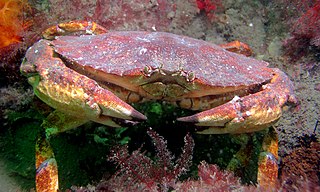
Cancer productus, one of several species known as red rock crabs, is a crab of the genus Cancer found on the western coast of North America.

Pagurus hirsutiusculus is a species of hermit crab, commonly called the hairy hermit crab. It lives from the Bering Strait south to California and Japan, from the intertidal zone to a depth of 110 m (360 ft).
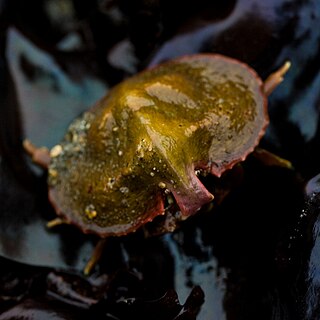
Cryptolithodes sitchensis, variously known as the umbrella crab, Sitka crab or turtle crab, is a species of lithodid crustacean native to coastal regions of the northeastern Pacific Ocean, ranging from Sitka, Alaska to Point Loma, California. Its carapace extends over its legs such that when it pulls in its legs, it resembles a small stone. It lives in rocky areas from the low intertidal to depths of 17 m (56 ft).

Diodora aspera, also known as the rough keyhole limpet, is a species of sea snail, a marine gastropod mollusk in the family Fissurellidae, the keyhole limpets. Although similar in appearance to a common limpet, it has a hole near the apex of its shell, and is only distantly related. It often has a scaled polychaete worm Arctonoe vittata living inside its shell as a commensal. In the event that it is attacked by a starfish, it extends flaps of mantle to defend itself, and the worm also helps drive the predator away.

Hapalogaster cavicauda is a species of king crab that lives on the Pacific coast of North America.
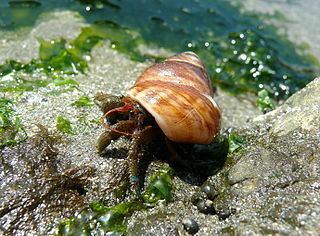
Pagurus samuelis, the blueband hermit crab, is a species of hermit crab from the west coast of North America, and the most common hermit crab in California. It is a small species, with distinctive blue bands on its legs. It prefers to live in the shell of the black turban snail, and is a nocturnal scavenger of algae and carrion.
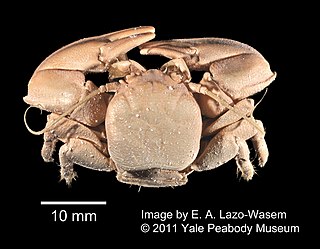
Petrolisthes eriomerus is a species of marine porcelain crab found in the eastern Pacific Ocean. It is commonly known as the flattop crab. It is a flattened, rounded animal, with a carapace up to 20 mm (0.8 in) across. It is a filter feeder, and also sweeps food from rocks.

Pugettia gracilis, commonly known as the graceful kelp crab, is a species of small crab in the family Epialtidae. It lives among forests of kelp on the Pacific coast of North America.

Dyspanopeus sayi is a species of mud crab that is native to the Atlantic coast of North America. It has also become established outside its native range, living in Swansea Docks since 1960, the Mediterranean Sea since the 1970s, the North Sea since 2007 and the Black Sea since 2010. It can reach a carapace width of 20 mm (0.8 in), and has black tips to its unequal claws. It feeds on bivalves and barnacles, and is in turn eaten by predators including the Atlantic blue crab, Callinectes sapidus. Eggs are produced from spring to autumn, the offspring reach sexual maturity the following summer, and individuals can live for up to two years. The closest relative of D. sayi is D. texanus, which lives in the Gulf of Mexico; the two species differ in subtle features of the genitalia and the last pair of walking legs.

Loxorhynchus grandis, commonly known as the sheep crab or spider crab, is a species of crab in the family Epialtidae. It is the largest crab found on the California coast. The species was first described to science by William Stimpson in 1857. The type specimen was collected on the coast of California, near San Francisco. Fossils from the late Miocene epoch indicate that this species is at least 11.63 to 5.333 million years old.

The gulf ghost crab, Hoplocypode occidentalis, is a species of ghost crabs native to the Pacific coast of the Americas, from the Gulf of California to Colombia. It is the only species in the genus Hoplocypode. Gulf ghost crabs are medium-sized, reaching a maximum overall body diameter of 6 in (15 cm). They are one of only two ghost crab species found in the eastern Pacific. However, gulf ghost crabs can easily be distinguished from painted ghost crabs by the absence of "horns" on their eyes.
Arctonoe vittata is a species of scaled polychaete worms commonly known as a "scale worm". This species often lives as a commensal of another marine animal.
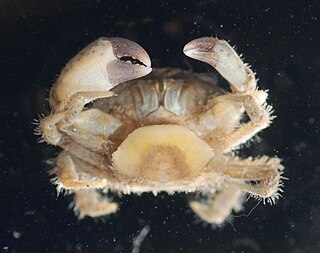
Loxothylacus panopaei is a species of barnacle in the family Sacculinidae. It is native to the Gulf of Mexico and Caribbean Sea. It is a parasitic castrator of small mud crabs in the family Panopeidae, mostly in the Gulf of Mexico, the Caribbean Sea and the eastern Atlantic Ocean.
Hippolyte californiensis, the California green shrimp, is a species of shrimp in the family Hippolytidae. It is native to the eastern Pacific Ocean. It was first described in 1895 by the zoologist S.J. Holmes from Bodega Bay, California. Of the 32 or so species in the genus Hippolyte, it is most closely related to H. obliquimanus and H. williamsi.

Megalorchestia californiana is a species of sand-hopper in the family Talitridae. It was first described in 1851 by the German naturalist Johann Friedrich von Brandt and is the type species of the genus Megalorchestia. It is commonly known as the long-horned beach hopper.

















